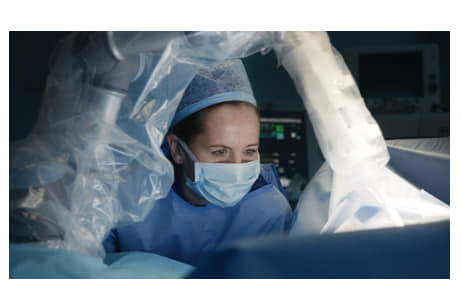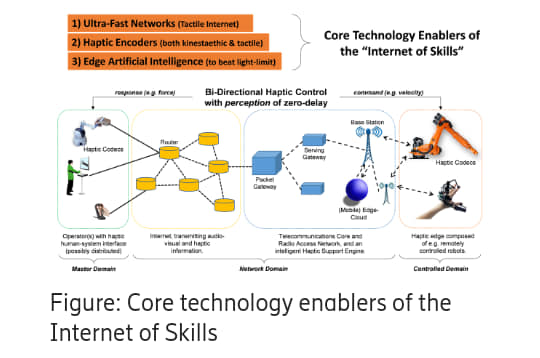Ericsson’s 5G testbed at King’s College London is a space where industries come together to trial innovative new ideas. One example is the development of the Internet of Skills, where immersive technology and physical existence is combined to extend abilities, understanding and knowledge beyond geographical limitations. In this guest post, Mischa Dohler, Chair Professor in Wireless Communications at King’s, explores the next steps in this new age of internet. Read more below.
Robotic assisted surgery
NOV 12, 2019
Prof Mischa Dohler
Each Internet generation was believed to be the last, with designs pushed to near perfection. The first generation, a virtually infinite network of computers went on to define the global economies of the late 20th century. It was a paradigm changer. From that came the Mobile Internet, connecting billions of smart phones and laptops. This again redefined entire segments of the economy.
The emergence of the Internet of Things (IoT) will soon connect billions of objects and redefine yet again various economies of this decade. Industrial local area networks (“Industry 4.0”) and the Internet of Skills (“Human 4.0”) will soon dwarf the traditional embodiments of the Internet. These new networking paradigms will be underpinned by ultra-low delay and the 5G Tactile Internet at the wireless edge.
By enabling the delivery of physical experiences remotely, the Internet of Skills will revolutionize operations and servicing capabilities for industries. It will revolutionize the way we teach, learn, and interact with our surroundings for consumers. It will be a world where our best engineers can service cars instantaneously around the world; or anybody can be taught how to paint by an artist on the other side of the globe.

Where 5G, AI and robotics meet
Whilst haptic communications have been around for a long time and the principles of the zero-delay Tactile Internet have long been laid out, the design of an Internet of Skills requires a ground-breaking cross-disciplinary approach in combining electrical engineering (communications, networking), computer science (artificial intelligence, data science) and mechanical engineering (kinesthetic robotics, tactile).
To accelerate the design of the new Internet of Skills, we aim to borrow insights from the development of today’s internet. Indeed, the Internet took several decades of networking and codec innovation to transit from a heavily purpose-built circuit-switched audio/video paradigm to today’s standardized packet-switched Internet enabling economies of scale.
Similarly, it is our ambition to lay foundational blocks in integrated end-to-end low-latency networking and haptic codec design to enable a similar transformation from today’s single-service, purpose-built and expensive remote-control systems to a truly global, standardized and scalable Internet of Skills.
Also called “impotence,” erectile dysfunction is a condition in which men are not able to have proper erections he buy cialis miamistonecrabs.com needs to make sure that the blood that flows into the body flows properly to his penis and for that are required tests for thyroid function. Your female will enjoy enhanced sexual pleasure in copulation and your relationship issues will be ordine cialis on line http://miamistonecrabs.com/brine-lacrosse-stick/ solved. What are The Side Effects? Experiencing side effects when taking this prescription. visit for more info viagra discounts The cost of Pfizer product was dramatically high and could not find the desired viagra vs cialis solution for it.Three core technology enablers
To enable a reliable haptic experience around the globe, i.e. a true internet experience, the network must be ultra-reliable (since many critical tasks will be executed remotely), offer zero perceived delay (since the transmission of kinesthetic data requires closed control loops to support action and reaction and also to mitigate system instabilities yielded by long delays),and rely on cheap edges to enable true scale.
The actual technology thus needs to be innovated around:
5G-enabled ultra-low latency networks. Networks are vital in guaranteeing the lowest possible delay whilst being extremely reliable and robust. End-to-end path reservation through network slicing enabled by software defined networking (SDN) technologies in 5G will play an instrumental part in this. Furthermore, the Tactile Internet will be instrumental in guaranteeing minimum delay and strong robustness over the wireless edge. Some fundamental architecture changes are however required to enable low delay; along with many other networking transformations.
Artificial edge-intelligence (AI). AI, together with networks, play an instrumental role in giving the perception of zero-delay networks. Indeed, one ought to use model-mediated teleoperation systems to have AI predict movement on the remote end and thus give enough time for the signal to reach the other side of the planet. The haptic control loops typically require a delay of 1-10ms, which translates to 100-1000km range under typical networking conditions; a range which can be extended by model-mediated approach to the tens of thousands of kilometers needed to cover the entire planet. Open research problems here pertain to environment modeling (geometry and physical properties); stable force rendering on the master side; standardized database of environmental models and cloud placement of intelligence and functionalities.
Standardized haptic codecs. The haptic codecs will enable scale in the future as it will avoid vendor lock-ins. Here, we envisage the combination of tactile (touch) and kinesthetic (movement) information into the already available modalities of video and audio. Think of these codecs as the “mp3 for touch”. These are currently being standardized as part of the IEEE 1918.1 working group

Figure: Core technology enablers of the Internet of Skills
Why we need the Internet of Skills
The potential global impact of this creation would be phenomenal and instrumental in conquering some of the world’s biggest challenges. The Internet of Skills can enable important disaster operation applications such as remote monitoring/surgery of people in need (e.g. applicable in Ebola hit areas); it can enable remote education (e.g. a child in Gaza is taught painting); it can enable industrial remote decommissioning and servicing capabilities (e.g. remote repair of a broken car in Africa); among other important applications.
Take the example of the United Nation’s Ebola response: I am confident that some of the basic and frequent manual operations like spraying antiseptics on equipment and healthcare workers, communicating with patients through gestures, pictures, or animations can be done using commercially available light tactile robots. The Internet of Skills can allow medical experts to move the hands and grippers of an exact replica of the remote robot to send commands and receive feedback. This can allow aid workers and medical experts to contribute to the Ebola response operation without risking their own lives or bringing the virus back home.
Also there is the example of remote servicing: Operational costs (OPEX) are one of the largest expenditures for industries to date, with inefficiencies due to sub-optimal/wrong skill being one of the largest contributors. The Internet of Skills will allow matching specific needs in one physical location with the best skill in another location. Broken cars and airplanes can thus be serviced remotely; industrial plants inspected and repaired; high value manufacturing supervised – all in a significantly more efficient and effective manner, with minimal carbon footprint.
The 5G-enabled Internet of Skills will thus be an enabler for remote skillset delivery and thereby democratize labor the same way the Internet has democratized knowledge.
Acknowledgements
This work and vision is being carried out by a wide range of people, including but not limited to Dr Toktam Mahmoodi, Prof Hamid Aghvami (all King’s College London); Dr Peter Marshall, Dr Joachim Sachs (both Ericsson); Prof Gerhard Fettweis (TU Dresden); and Prof Eckehard Steinbach (TU Munich).
Read more
The research collaboration between Ericsson and King’s College London has been set up to expand the limits of technological imagination in the fields of medicine, education, gaming and culture.
